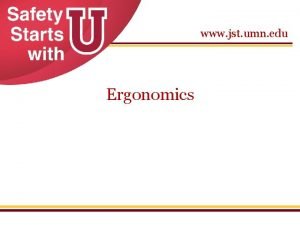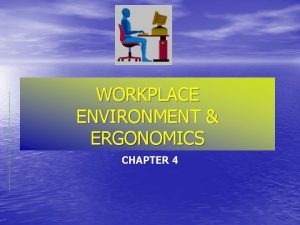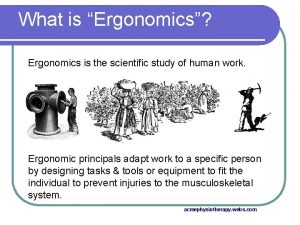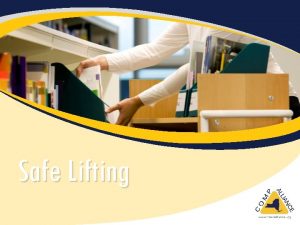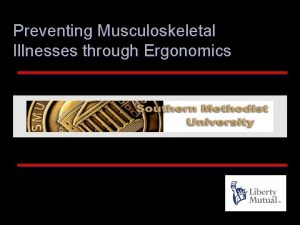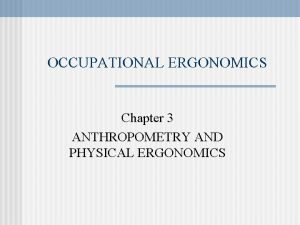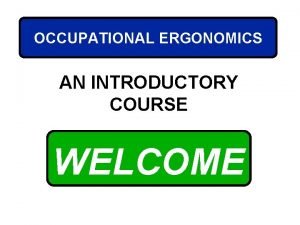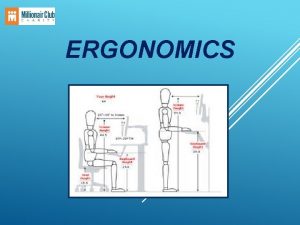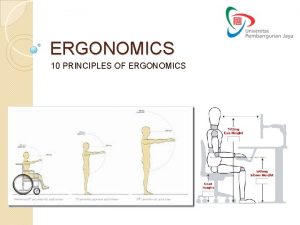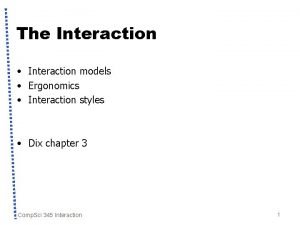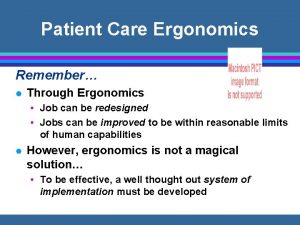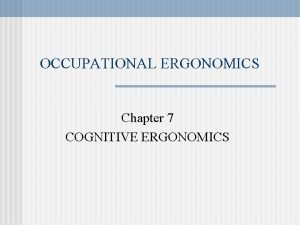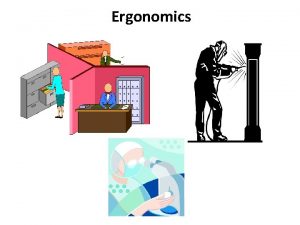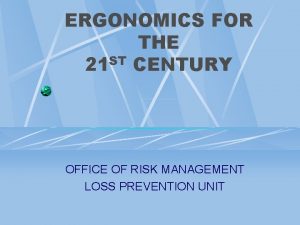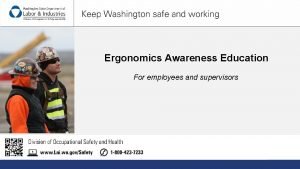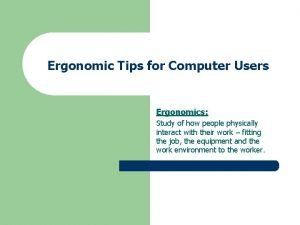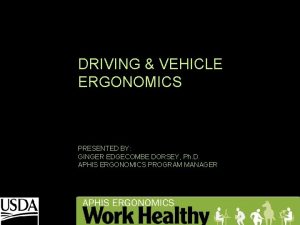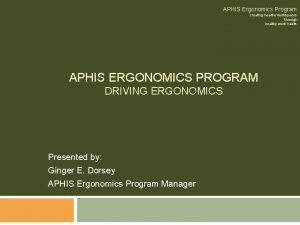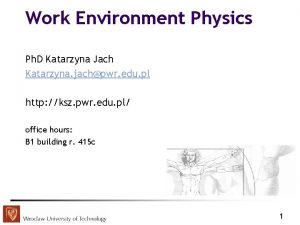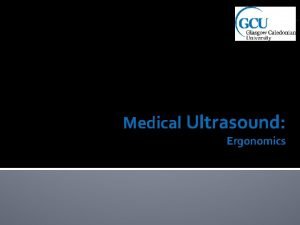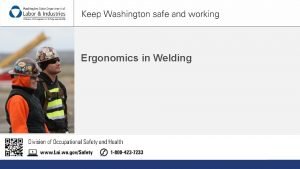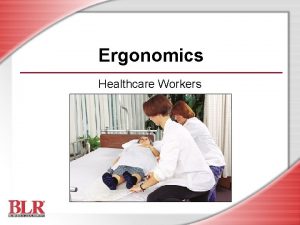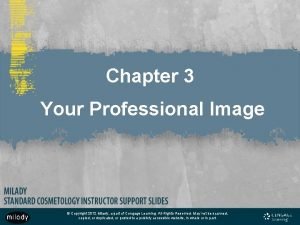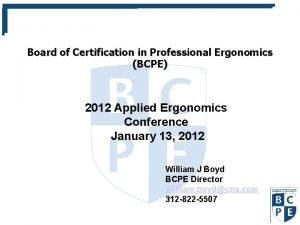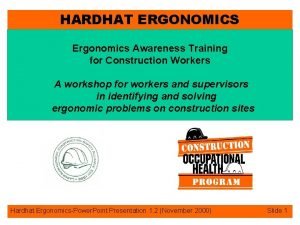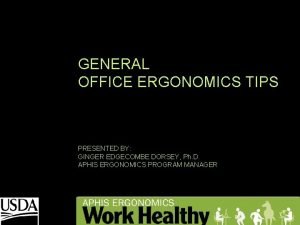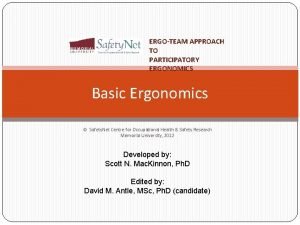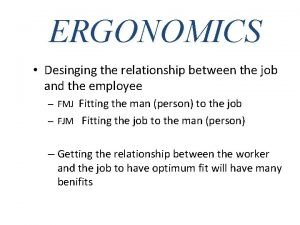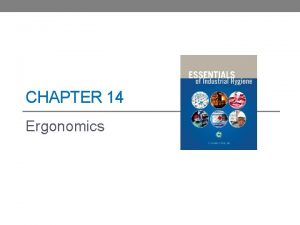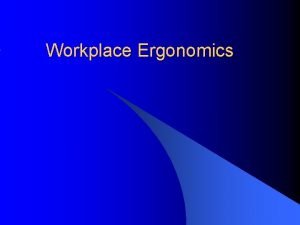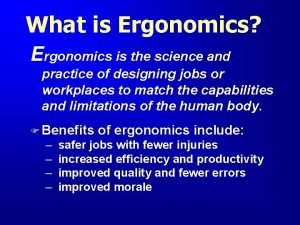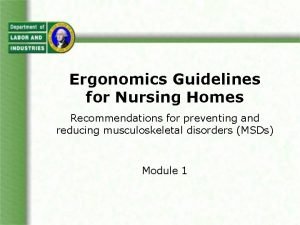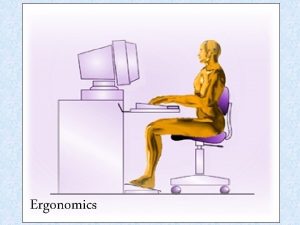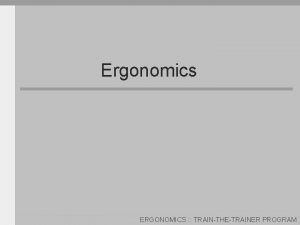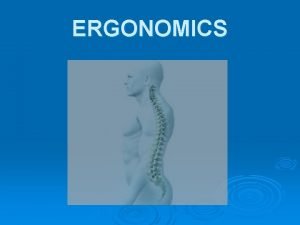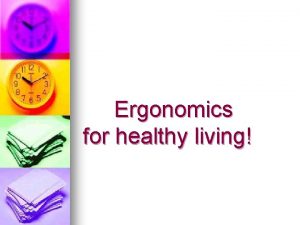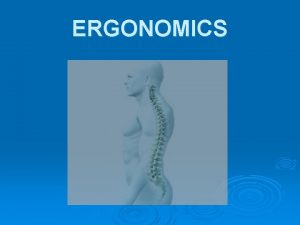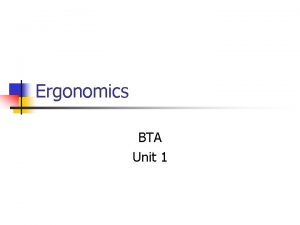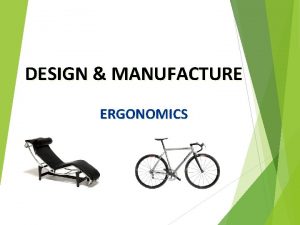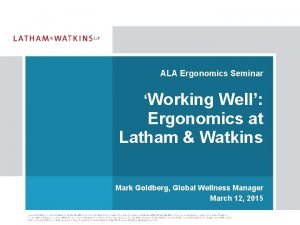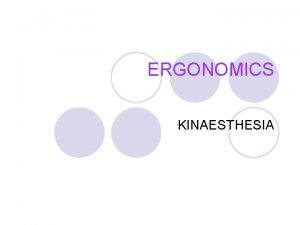ERGONOMICS WORK WHAT IS WORK l Work can












































- Slides: 44

ERGONOMICS “WORK”

WHAT IS WORK? l Work can be thought of simply as activity - either mental or physical. Your body is working constantly even when you are asleep! l You carry out mental work whenever you use your brain to do something - reading, watching television, solving a problem, etc. l You carry out physical work whenever you use your body to do something - walking, sitting, lifting, etc. Your body still works when you are asleep to digest food, repair tissues, keep you breathing, etc.

Types of physical work l Physical work is carried out by your muscles and is therefore often called “muscular work”. There are 2 types: l STATIC l DYNAMIC

STATIC (or isometric meaning 'same length'): l this is where a muscle remains contracted for a period of time but there is no movement, as in holding a picture against the wall or carrying a bag of shopping.

DYNAMIC (or isotonic meaning 'same tension'): l This is where there is rhythmical contraction and relaxation of a muscle which does result in movement, as in pulling open a drawer or walking up stairs.

l. Dynamic work is less tiring and more efficient than static work. l. This is because during dynamic work a muscle contracts and relaxes rhythmically which makes it act like a pump for the flow of blood in the blood vessels, allowing the blood to supply more oxygen and take away more lactic acid than during static work. l Hold a small book in each hand. Put one arm straight out in front of you and keep it in that position. This arm is doing static work. With your other arm, keep your elbow at your side and move your forearm up and down repeatedly. This arm is doing dynamic work. Which arm gets tired first? It's probably the one holding the book still in front of you and apparently doing nothing!


DYNAMIC AND STATIC WORK

Types of muscle l There are three types of muscle tissue in your body: l Smooth muscle tissue - located within the walls of various body organs; l Cardiac muscle tissue - which forms the heart; and l Skeletal muscle tissue - which forms the muscles that make you move. ¡ Skeletal muscle is made up of bundles of muscle fibres which can contract together in one direction. During movement, when a muscle contracts, the muscle fibres reduce in length so the amount of movement that the muscle can produce depends on the original length of these fibres. The strength of the muscle will depend on the number of fibres that it contains and the crosssectional area of the muscle.

Muscular endurance and strength l “Muscular endurance” is the ability of a muscle or a muscle group to remain contracted over a period of time. l Endurance can be static or dynamic. ¡ Static endurance can be determined by the length of time a limb can maintain a certain position, whereas ¡ Dynamic endurance can be measured by the number of times a limb can perform a movement against a certain resistance.

l “Muscular strength” is the maximum amount of force that a muscle can exert under maximum contraction. l The amount of force that can be exerted by your limbs depends on body posture and the direction of force. ¡ For example, when standing, you can exert more force when pushing backwards than when pushing forwards.

There are several factors that influence your muscle strength and endurance: l. Age: your strength increases in your teens and early 20 s, reaches its maximum by the middle to late 20 s, remains at this level for 5 to 10 years, and afterwards begins to decrease gradually.

Sex: l In general, women are about two thirds as strong as men. This is because men have greater muscle mass as a percentage of body mass compared to women.

Body build: l Usually the 95 th percentile person of a population will be stronger than the 5 th percentile person; the athletic or muscular looking person will tend to be stronger than others; among people of equal body size, differences in strength may be due to the amount of muscle tissue, body shape and proportions.

Fatigue: l The build up of lactic acid in the muscles due to static muscle work causes a gradual decline in muscle strength; fatigue can be delayed by adopting comfortable working postures, changing your posture now and again, decreasing the intensity or duration of muscular effort, training or practice, having adequate rest periods, and good nutrition.

Exercise: l You can increase your muscle strength and endurance through exercise up to the limits of your maximum physical potential, which is mainly determined by the genes you inherit from your parents.

Heat: l Heat, especially when combined with high humidity, decreases muscular performance, especially endurance.

Cold: l Cold will not affect muscle strength if you wear adequate protective clothing, but it may affect your manual dexterity.

Clothing & equipment: l Bulky clothing may make movement more difficult and you may not be able to achieve the best positions for exerting maximum force. Clothing and any equipment you carry will add to your overall weight and therefore you will need extra muscular energy to move.

Motivation and emotional state: l Fear, anger or excitement can temporarily increase your muscular strength but skill and accuracy may suffer.

Nature of your job: l Manual workers are significantly stronger than other types of worker.

Postural aids: l Backrests increase pushing strength by directing all your strength forwards.

Postural aids: l Footrests increase pulling strength by allowing you to brace your legs.

The amount of force that can be exerted by your limbs depends on your body posture and the direction of force that you apply. Maximum pulling forces (as percentage of body weight) Maximum pushing forces (as percentage of body weight)

Physical changes during muscular work l When you use your muscles and become active, several physical changes occur in your body: ¡You need and use more oxygen ¡Your breathing rate and depth increases ¡Your heart rate and blood flow increases ¡You sweat more ¡The chemical make up of your blood and urine changes

Oxygen supply and consumption l Muscular work involves the contraction of muscles, a process which requires energy. This energy is obtained through the breakdown of energy-rich glucose or fat. l When you are not being very active, oxygen is readily available and enough is supplied to the muscles to allow them to completely break down glucose and fat into energy, water and carbon dioxide. This process is called aerobic respiration. l When you are being very active, your muscles need more oxygen but it can't be supplied fast enough by the blood and glucose can't be broken down completely. Lactic acid is a by-product of this anaerobic respiration process and builds up in your muscles which you feel as an ache or pain in your muscles. l When you rest again and you supply enough oxygen to your muscles, this lactic acid is converted into glycogen and the muscle ache disappears. l People who are physically fit can sustain the aerobic process for a longer time than those who are unfit, that is, they are able to supply oxygen to the working muscles at a higher rate and therefore lactic acid doesn't accumulate as fast as in unfit people.

l For light work, you need from 0. 5 to 1. 0 litre of oxygen per minute l For moderate work, you need from 1. 0 to 2. 0 litres of oxygen per minute l For heavy work, you need more than 2. 0 litres of oxygen per minute l During light or moderate activity your oxygen supply keeps pace with the requirements of your muscles. At this stage work is being done aerobically. A steady state of oxygen consumption is reached and maintained throughout the period of muscular work. However, during industrial or recreational activities, a steady rate of work is seldom maintained for a prolonged period so the steady state is rarely attained.

l During heavy work, the oxygen supply increases but soon becomes inadequate and the aerobic processes are replaced by anaerobic. l At this point your muscles become short of oxygen which results in an 'oxygen debt'. This 'oxygen debt' refers to the extent to which anaerobic processes contribute to the performance of work. This must then be paid off at the end of the work period. The harder you work and therefore the greater the anaerobic contribution, the longer it takes you to recover.

Heart rate l During increased activity the volume of blood flowing into the heart increases as the working muscles help to pump the blood back to the heart. This stretches the heart muscle which then contracts more forcefully, so more blood is expelled with each beat (called the stroke volume). The nervous system also increases the number of heart beats per minute (the heart rate). Both of these together result in much more blood being pumped by the heart. l During hard work your heart rate increases up to about three times its resting value (for example from 60 beats to 180 beats per minute). When the activity stops, your heart rate returns to resting levels. The speed with which the rate falls back to resting levels depends on your fitness; the fitter you are, the faster your recovery.

Your level of fitness affects your physical state during work and your recovery in several ways: Measurement Fit person Unfit person Oxygen consumption Same Heart rate Lower Higher Stroke volume Larger Smaller Lactic acid concentration in blood Lower Higher Return of heart rate to normal after work Faster Slower

Fatigue can describe a variety of conditions such as: ¡Decrease of attention ¡Slowed and impaired perception ¡Decrease in motivation ¡Decrease in the speed of physical and mental performance ¡Decrease in accuracy and increase in errors ¡Greater energy expenditure to keep up the same output ¡Feelings of dullness, tiredness, irritability

l Fatigue can result from hard physical effort or prolonged but less physical activity. ¡Your efficiency in a job depends on a number of things, for example, your ability to do the tasks involved, your capacity for physical work, the design of the instruments, tools and machines that you use, your workplace layout, and your training. ¡However, any prolonged work, physical or mental, is tiring and you can't work all your waking hours without fatigue.

If you have a light industrial job, you might perform one or more of the following tasks: l Repetitive work: you repeat the same sequence of operations continuously, for example on assembly lines l Monitoring: you watch for signals which may occur at infrequent intervals, for example in control rooms, or production inspection l Driving: you drive railway locomotives, road vehicles, cranes or rolling mills l Machine minding: you watch automatic or semiautomatic machines for changes l Quality control: you check goods for faults

l After any of these tasks has been continued for some time, you would probably need a break, or your performance would deteriorate. l There is a limit to the length of time you can keep up maximum concentration which depends on you and the type of task you are doing. In a continuous task, you might start to work unevenly, or you might miss signals or make some other mistake, or even have an accident.

Fatigue may not necessarily arise due to having too much work to complete. l Boredom or monotony are special factors that can lead to fatigue. These occur when there is no stimulation in either the work itself or the working environment and may happen when: l You're not interested or motivated by the work l The work makes no demands on your skills l The work rate is too slow for you l Your work environment is dull

l In order to reduce fatigue, you need to take a break from the activity that has made you fatigued. This can be either a complete rest or just a change of activity. l If a break or a rest pause is taken at appropriate times, a fresh period of optimum activity will result.

There are four types of work pauses: l Spontaneous: taken by the worker, especially during strenuous work. l Disguised: these may form secondary work that is not necessary at a given moment for the task in hand, e. g. cleaning a machine part, tidying the work bench, etc.

l Work-conditioned: these are waiting periods dependent on the organisation of the work or the movements of a machine. On conveyor belts, the length of the workconditioned pause depends on the skill and work rate of the operator. The waiting time for the next piece of work increases with the skill at which work is performed. l Prescribed: these are usually taken at a set time in the form of tea breaks or lunch breaks.

The following work-rest programmes are usually recommended for industrial workers: l Medium intensity work with waiting times created by the working process: one break in the morning and one in the afternoon, of 10 -15 minutes each. Refreshments should be available. l High intensity work without waiting time and with a high work rate: a refreshment pause in the morning and in the afternoon, and one or two short pauses of 5 minutes each during each half of the working day.

Increasing your ability for work l Physical activity l Mechanical devices and electronic instruments are taking over the more physical parts of many jobs, with the result that workers do not need to be so fit to do the same job. l This decrease in activity at work is thought to be one of the factors contributing to the increase in coronary heart disease in developed countries. ¡ Coronary heart disease is twice as frequent in sedentary (sabit, oturarak çalışan) people as it is in active people.

l Medical evidence also suggests that an increase in physical activity acts both as a preventive measure against coronary heart disease and results in improved physical fitness, that is, a greater capacity to cope with work, leisure activities and neuromuscular (sinir-kas) stress.

Nutrition l A diet that contains a variety of foods in sufficient quantity to maintain normal body weight and support growth is usually adequate for all individuals whether they are sedentary or athletic. l A normal, balanced diet means eating appropriate amounts of carbohydrates, proteins, fats and oils, vitamins and minerals. Carbohydrates include sugar and starchy foods and form the body's main source of energy. They are an essential, but not exclusive, fuel for muscles. Proteins are used for growth and for repairing body tissues. Protein may also be used as fuel if carbohydrates and fats are not available, for example, during starvation. If you are training for an athletic event, it is recommended that your diet should include approximately 60% carbohydrate and 15% protein.

l Fats are an important source of energy at rest and for low intensity exercise, and are readily stored in the body. All foods contain stored energy. The amount of energy that your body can obtain from food is measured in kilojoules (k. J). Your body can obtain 17 k. J from 1 gram of carbohydrate or protein and 38 k. J from 1 gram of fat but as it requires more oxygen to do this, it is not used when the oxygen supply can't meet the extra requirement, for example when you are doing heavy work. l Different activities require different energy levels. The table below gives examples of energy requirements for some activities, in kilojoules per hour (for a 25 year old man weighing 65 kg).

Activity level Every day activities Examples of activity Energy requirement k. J/h Sitting 6 Standing 7 Washing, dressing 15 Walking slowly 13 Walking moderately quickly 21 Walking up and down stairs 38 Light work & recreation Most domestic work, golf, light industrial and assembly work, carpentry, bricklaying 10 -20 Moderate work & recreation Gardening, tennis, dancing, cycling up to 20 km/hr, digging, shovelling, nonmechanised agricultural work, 21 -30 Strenuous work & recreation Coal mining, steel furnace work, squash, cross-country running, football, swimming Over 30
 Ergonomics
Ergonomics Workplace environment and ergonomics
Workplace environment and ergonomics Types of ergonomics
Types of ergonomics Ergonomics lifting techniques
Ergonomics lifting techniques Ergonomics and anthropometrics
Ergonomics and anthropometrics Ergonomics session
Ergonomics session Types of ergonomics
Types of ergonomics Objectives of ergonomics
Objectives of ergonomics Ergonomics case study
Ergonomics case study Types of ergonomics
Types of ergonomics Ergonomics in textile industry
Ergonomics in textile industry Bathroom ergonomics
Bathroom ergonomics 10 principles of ergonomics
10 principles of ergonomics Six pillars of ergonomics
Six pillars of ergonomics What is ergonomics
What is ergonomics Slip human error
Slip human error Patient care ergonomics
Patient care ergonomics Types of ergonomics
Types of ergonomics Ferro foundries pvt ltd
Ferro foundries pvt ltd Ergonomics visual display
Ergonomics visual display Types of ergonomics
Types of ergonomics Types of ergonomics
Types of ergonomics Ergonomics awareness training for supervisors
Ergonomics awareness training for supervisors Ergonomics awareness training for supervisors
Ergonomics awareness training for supervisors Ergonomics tips for computer users
Ergonomics tips for computer users Controller ergonomics
Controller ergonomics Driving ergonomics checklist
Driving ergonomics checklist Types of ergonomics
Types of ergonomics What do you see in this picture
What do you see in this picture Ergonomicsl
Ergonomicsl Objectives of ergonomics
Objectives of ergonomics Ultrasound ergonomics
Ultrasound ergonomics Ergonomics in welding
Ergonomics in welding Objectives of ergonomics
Objectives of ergonomics Milady chapter 3
Milady chapter 3 Https://iehf.org/web-design-ergonomics-checklist/
Https://iehf.org/web-design-ergonomics-checklist/ Find ergonomics awareness training
Find ergonomics awareness training Office ergonomics
Office ergonomics Ergoteam
Ergoteam Ergonomics definition
Ergonomics definition Objectives of ergonomics
Objectives of ergonomics What is ergonomics
What is ergonomics Ergonomics is the science of
Ergonomics is the science of Ergonomics in human computer interaction
Ergonomics in human computer interaction Ergonomics
Ergonomics
